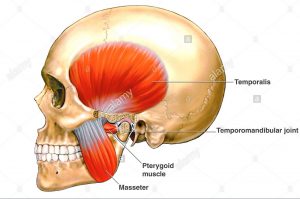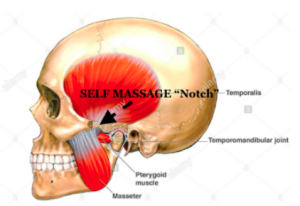Author: Adrianna Aguilar
It is estimated that TMJ Disorders affect over 10 million Americans, yet there is still a great deal to learn about TMJ, about its surrounding disorders and about its origins. In recent years, The US Department of Health of Services discovered that “the condition was more common in women than in men.” (1) With so little known and so much more to be discovered in regards to TMJ, how can those of us affected combat its negative effects and pain?
TMJ itself stands for temporomandibular joint and refers to the jaw joint.

(2) Temporomandibular joint and Masseter
Connecting the lower jaw and the bone to the side of the skull, it is one of the more complex joints in the body. With the help of the masseter muscle, the TMJ allows for movement both up and down as well as side to side. Both the TMJ and masseter make for an extraordinary pair with the masseter ranking as one of the strongest muscles in the body. Achiness, headaches, migraine, or throbbing in and around your ear could mean that the TMJ is inflamed and/or the masseter muscle is tense. (3, 4) As humans, we need to eat, which means we call on this mighty duo to get us through. When both are not working as efficiently and as painless as possible, our team at JFPT is ready to assist and offer our expertise and skill. There are also ways for you yourself to self soothe TMJ pain at home. Please make sure to check in with a Physical Therapist or Massage Therapist if you are suffering from TMJ symptoms and before proceeding with self-massage techniques.

(4) Note where the “Self Massage Notch” is.
What are the Benefits of Temporomandibular Joint (TMJ) Physical Therapy Treatments?
Temporomandibular joint (TMJ) disorder causes pain and discomfort in the jaw, face, neck, and shoulders and can also cause headaches, earaches, and difficulty opening or closing the mouth. TMJ therapy is a treatment that can help manage the symptoms of the disorder and improve quality of life. Below is a list of significant ways how TMJ therapy can do that:
Relief from Pain and Discomfort – the main benefit, indeed its purpose, of TMJ therapy is pain relief. Depending on the level of pain and discomfort, TMJ therapy may include a combination of treatments such as physical therapy, medication, and surgery. While drugs can help with pain relief only and will not fix the underlying problem, physical therapy can help to relieve muscle tension and improve the range of motion in the jaw. Surgery may be recommended in some severe cases where neither medication nor physical therapy are enough.
Improved Quality of Life – temporomandibular joint disorder may significantly impact the patient’s quality of life. By improving the overall function of the jaw, Temporomandibular joint TMJ therapy may have significant pain reduction qualities. Together with reducing discomfort, it can significantly improve the patient’s well-being.
Reduced Risk of Long-Term Complications – untreated TMJ disorder can lead to long-term complications such as chronic pain, arthritis, and damage to the joint.
Customized Treatment Plans – every person’s TMJ disorder is unique, so TMJ therapy should be customized. At James Fowler Physical Therapy, our NYC physical therapist will tailor your TMJ treatment to your specific circumstance and cater to your particular needs.
Improved Dental Health – untreated TMJ disorder can significantly negatively impact your dental health. By forcing your teeth to grind and clench, the Temporomandibular joint can lead to tooth damage and decay. By fixing those problems, TMJ therapy can improve your overall dental health.
Suppose you are experiencing symptoms of TMJ disorder. In that case, speaking with a physical therapist experienced with TMJ therapy is essential because, with the proper care, you can manage your symptoms and enjoy a better quality of life.
Massaging the Masseter
-
- The masseter muscle extends from below the cheekbone on the side of the face as seen above. The bottom of the masseter attaches to the side of the jawbone.
- Find “the Notch” about one inch in front of your ears on the underside of the cheekbones. Press firmly inwards and upwards using your thumb into this area.
- Please do not proceed without checking in with a physical therapist or massage therapist.
